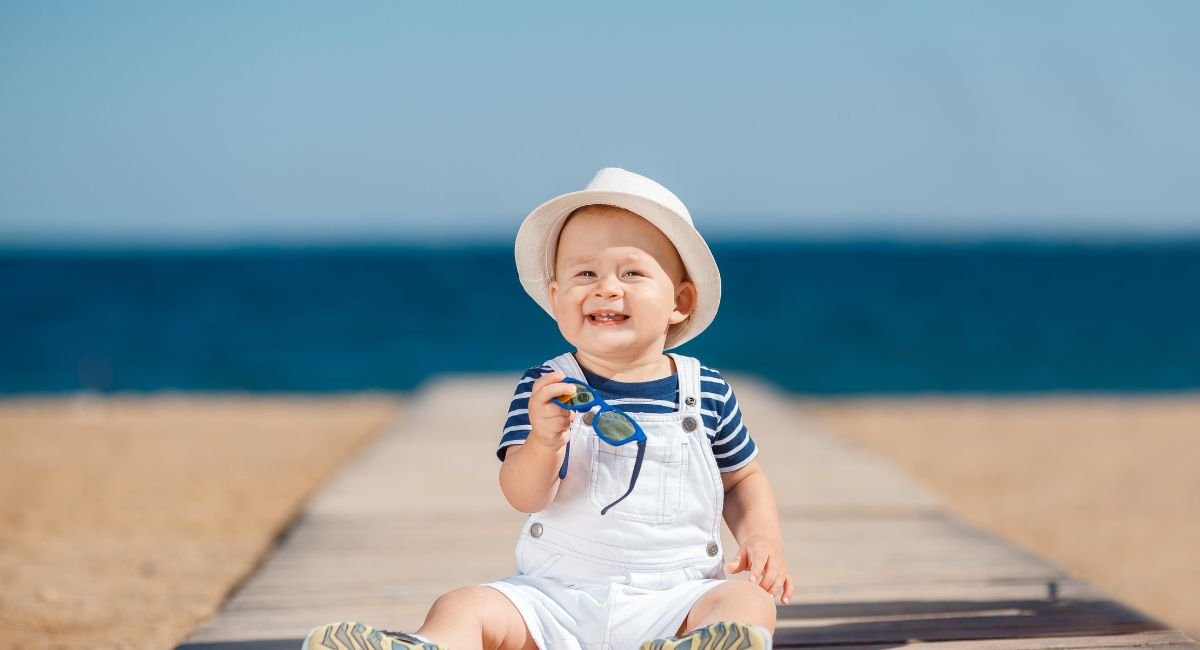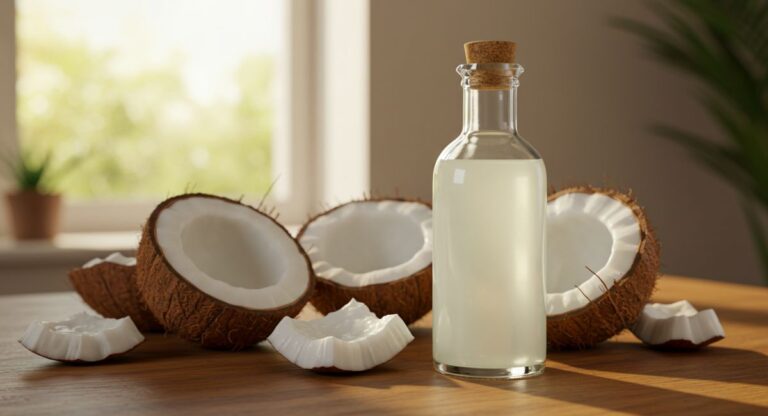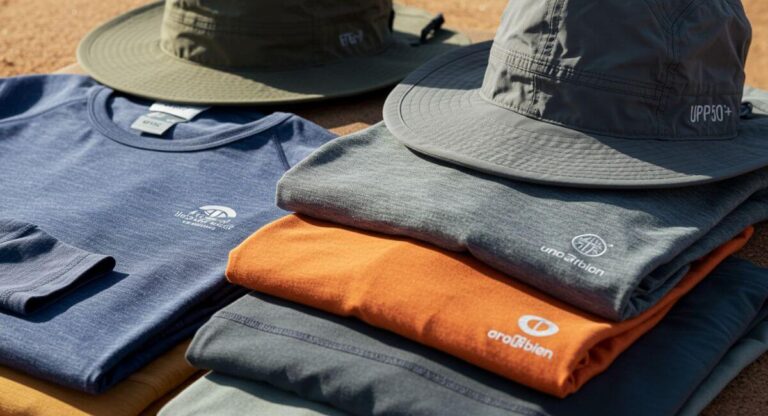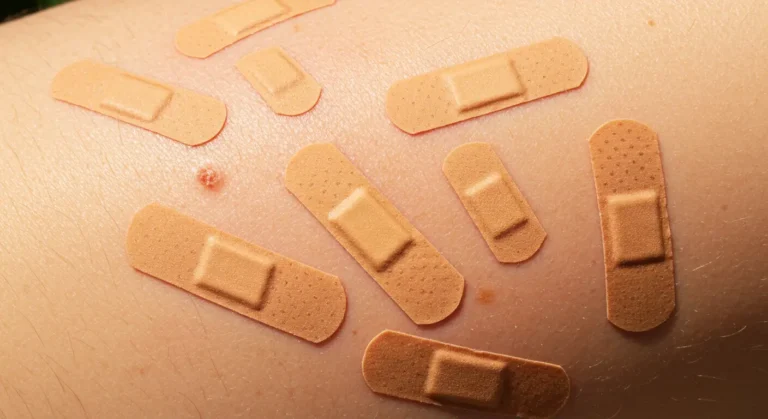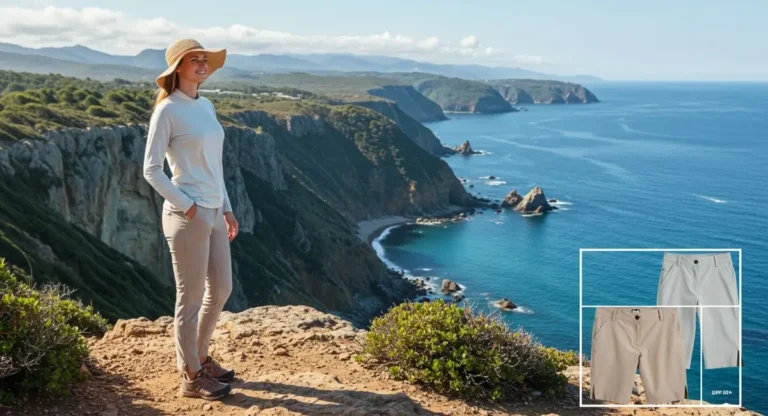Newborn Sun Protection Clothing Review: For Your Little One
Introduction: Keeping Delicate Skin Safe
Did you know that a baby’s skin is approximately 30% thinner than adult skin, making it significantly more vulnerable to sun damage? This startling fact underscores why newborn sun protection clothing isn’t just an accessory—it’s a necessity for your little one’s health and comfort. As parents, ensuring our babies are protected from harmful UV rays becomes a top priority, especially during those first precious months.
The importance of proper newborn sun protection clothing cannot be overstated. Unlike adults, babies haven’t yet developed the melanin needed to provide natural sun protection, leaving them particularly susceptible to sunburn and potential long-term skin damage. According to the American Academy of Pediatrics, babies under six months should be kept out of direct sunlight whenever possible, making protective clothing your first line of defense against harmful rays.
In this comprehensive newborn sun protection clothing review, we’ll explore the most effective options available, their benefits, potential drawbacks, and everything you need to know to make informed decisions about safeguarding your little one from the sun.
Key Features of Quality Newborn Sun Protection Clothing
When searching for the perfect newborn sun protection clothing, understanding the technical features that provide actual protection is crucial. Not all baby clothes are created equal when it comes to sun safety.
UPF Rating
The most important feature to look for is the Ultraviolet Protection Factor (UPF) rating. This measurement indicates how effectively fabrics block ultraviolet radiation:
- UPF 15-24: Good protection (blocks 93.3-95.9% of UV radiation)
- UPF 25-39: Very good protection (blocks 96.0-97.4% of UV radiation)
- UPF 40-50+: Excellent protection (blocks 97.5-98%+ of UV radiation)
For newborns, experts recommend choosing clothing with UPF 50+ for maximum protection, which blocks 98% or more of harmful UV rays.
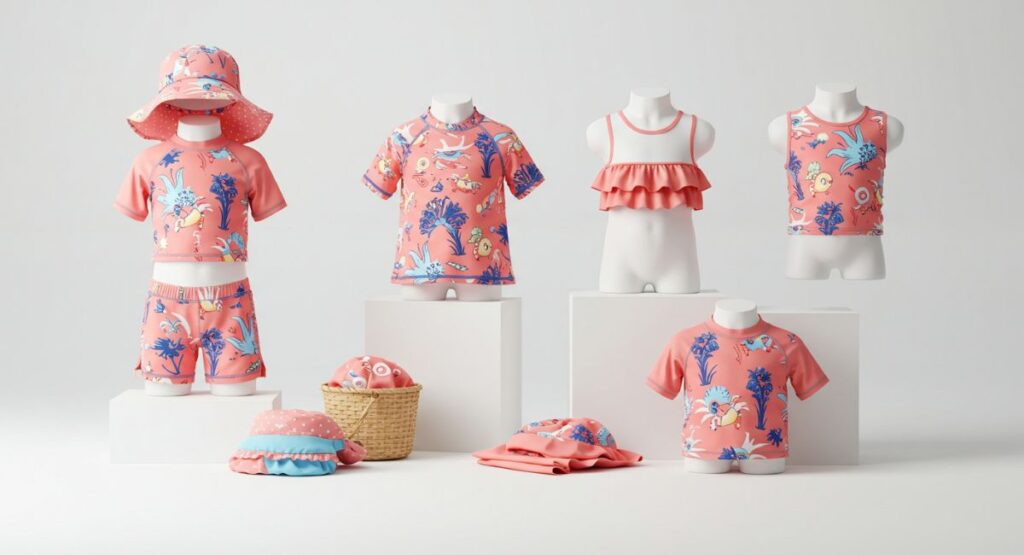
Fabric Technology
The science behind sun-protective fabrics has advanced significantly in recent years. The best newborn sun protection clothing utilizes specially engineered fabrics that:
- Feature tight weaves that physically block UV penetration
- Incorporate zinc oxide or titanium dioxide particles embedded in the fabric
- Use specially treated cotton blends that provide protection without sacrificing breathability
- Maintain protection even when wet (crucial for water play or excessive drooling)
Leading brands like RuffleButts, SwimZip, and Coolibar have patented fabric technologies specifically designed for infant skin protection.
Certifications
Look for clothing with recognized certifications such as:
- Skin Cancer Foundation Seal of Recommendation
- ASTM International testing verification
- Australian Radiation Protection certification
These third-party verifications ensure the clothing meets rigorous standards for sun protection.
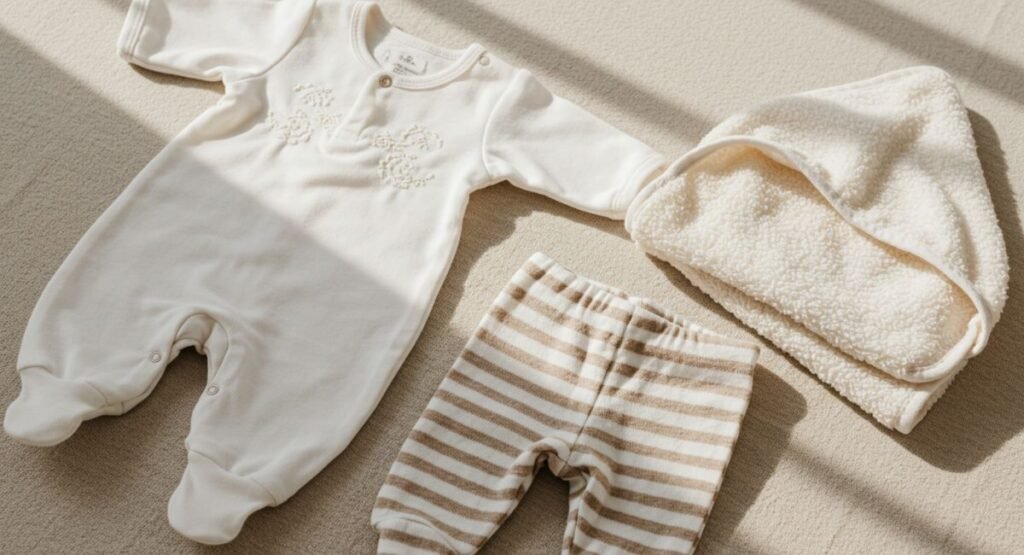
How Newborn Sun Protection Clothing Works
Unlike sunscreen, which uses chemical or mineral barriers to absorb or reflect UV rays, newborn sun protection clothing works through physical blocking of ultraviolet radiation. The effectiveness stems from three primary factors:
- Weave Density: Tightly woven fabrics create smaller spaces between threads, preventing UV rays from passing through to the skin. This is why regular t-shirts (particularly when wet) provide far less protection than specialized sun protective garments.
- Material Composition: Synthetic fibers like polyester and nylon naturally block more UV radiation than natural fibers. However, specially treated cotton blends can achieve excellent protection while maintaining the softness ideal for newborn skin.
- Special Treatments: Many manufacturers apply UV-absorbing treatments to fabrics, creating an additional defensive layer. These treatments are designed to be baby-safe and maintain effectiveness through multiple washes.
Dermatologist Dr. Sarah Peterson notes, “The difference between regular clothing and UPF-rated garments can be substantial. A standard cotton t-shirt might offer UPF 5-7, while properly designed sun protective clothing provides UPF 50+, blocking over 98% of harmful rays.”
Step-by-Step Guide to Dressing Your Newborn for Sun Protection
How to Layer Sun Protection for Complete Coverage
Properly dressing your newborn for sun protection requires a systematic approach to ensure no delicate skin remains exposed:
- Start with a base layer: Choose a lightweight, UPF-rated onesie that covers the torso completely.
- Add extremity protection: Cover arms and legs with sun protective sleeves or pants. For newborns, one-piece options often provide the most comprehensive coverage.
- Don’t forget the neck: Select clothing with high neck designs or add a neck flap hat for additional protection of this often-overlooked area.
- Protect the face and head: Use a wide-brimmed hat (minimum 3-inch brim) with neck flap protection.
- Consider hand and foot coverage: For complete protection, select styles with fold-over mittens and foot coverings, especially for very young infants.
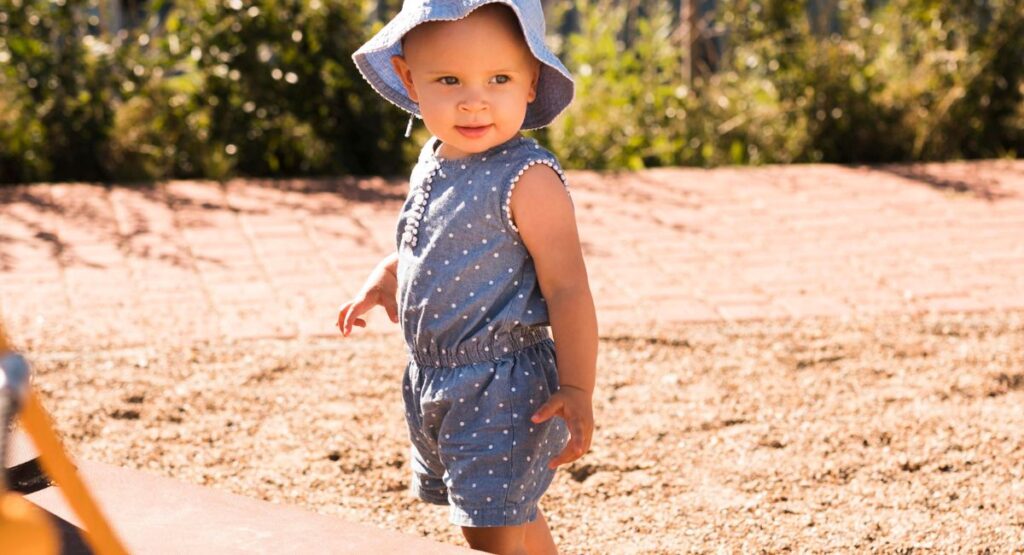
When and Where to Use Different Types of Protection
Different environments require different approaches to sun protection:
- Beach or pool: Full-coverage swimwear with UPF 50+ rating is essential
- Everyday outings: Lightweight long-sleeve options with breathable fabrics
- Stroller time: Combine clothing with physical barriers like stroller shades
- Morning walks: Even during less intense sun hours, basic protection is recommended
Benefits and Drawbacks of Newborn Sun Protection Clothing
Benefits
- Continuous Protection: Unlike sunscreen that requires reapplication, sun protective clothing provides constant coverage as long as it’s worn properly.
- Gentle on Sensitive Skin: Avoids potential irritation from sunscreen chemicals, making it ideal for newborns under six months for whom sunscreen is not recommended.
- Cost-Effective: While the initial investment may be higher than regular clothing, the durability and protection offered make it economical over time.
- Convenience: Eliminates the struggle of applying sunscreen to a squirming baby.
- Peace of Mind: Provides parental confidence in your baby’s protection from harmful rays.
Drawbacks
- Higher Cost: Quality newborn sun protection clothing typically costs more than standard baby clothes.
- Limited Style Options: While improving, design choices can be more limited than regular baby clothing.
- Potential Overheating: Some UPF fabrics may be less breathable, requiring careful monitoring of baby’s temperature.
- Still Requires Additional Protection: Areas like the face may still need sunscreen or physical barriers.
Options and Comparisons
When considering newborn sun protection clothing, several options deserve comparison to help you make the best choice for your baby:
Full-Coverage Rompers vs. Separates
Full-coverage rompers offer the convenience of one-piece protection but may be challenging for diaper changes. Separates provide flexibility but could expose skin if they ride up or shift.
SwimZip Boys’ Long-Sleeve UPF 50+ Swimsuit for Baby, Toddler, & Little Boys provides excellent full-body coverage with UPF 50+ protection and convenient zipper design for easy changes. The attached hood adds extra neck and head protection.
Swim Protection vs. Everyday Sun Wear
Specialized swimwear typically features quick-drying, chlorine-resistant fabrics ideal for water activities but might be less comfortable for all-day wear. Everyday sun wear prioritizes breathability and softness.
The RuffleButts Baby Girl Long Sleeve Rash Guard Set combines UPF 50+ protection with adorable design elements, making it perfect for beach days while keeping your little one protected and stylish.
Budget Options vs. Premium Brands
While premium brands often incorporate advanced fabric technologies and more durable construction, several budget-friendly options provide adequate protection:
Simple Joys by Carter’s Girl UPF 50+ Swim Set offers reliable sun protection at a more accessible price point while maintaining quality standards and cute designs.
Hat Options for Complete Protection
A quality sun hat is essential to protect your baby’s scalp, face, ears, and neck:
The i play. by green sprouts Baby Flap Sun Protection Hat features UPF 50+ fabric, adjustable sizing, and an extended neck flap for comprehensive coverage of delicate areas.
Real-World Scenarios: When and How to Use Sun Protection Clothing
Understanding how to integrate newborn sun protection clothing into various situations helps ensure your baby stays safe in any environment:
At the Beach
Full coverage is non-negotiable at the beach, where UV exposure is intensified by water and sand reflection:
- Use full-body swimwear with UPF 50+
- Add a wide-brimmed hat with neck protection
- Create shade with a beach tent or umbrella
- Limit exposure during peak sun hours (10am-4pm)

During Daily Walks
Even brief outdoor exposures require protection:
- Dress baby in lightweight long sleeves and pants with UPF protection
- Use stroller covers as an additional barrier
- Plan walks for early morning or late afternoon when possible
- Remember that clouds don’t block UV rays effectively
For Backyard Time
Creating safe sun experiences in your own yard:
- Set up shaded play areas using canopies or natural shade
- Dress baby in breathable sun protective clothing appropriate for the temperature
- Use UPF blankets for tummy time outdoors
- Monitor exposure time and watch for signs of overheating
Common Mistakes to Avoid with Newborn Sun Protection
Avoiding these frequent errors will help maximize your baby’s sun safety:
Relying on Regular Clothing
Standard baby clothes typically offer minimal sun protection (UPF 5-7). This protection decreases further when fabrics become wet or stretched. Always choose specially designed sun protective clothing with verified UPF ratings.
Forgetting Consistent Coverage
Sun exposure can happen during brief moments—like transferring baby from car to stroller. Develop habits of dressing for protection before leaving home rather than responding to sun exposure after it begins.
Neglecting the Shade Factor
Even the best newborn sun protection clothing should be complemented by seeking shade. According to the American Academy of Dermatology, combining protective clothing with shade strategies reduces UV exposure by up to 80%.
Overlooking Hat Importance
Many parents focus on body coverage but neglect adequate hat protection. A proper sun hat should:
- Have a wide brim (3+ inches)
- Include neck flap protection
- Feature adjustable chin straps to keep it in place
- Be made of UPF 50+ material
Assuming Cloudy Days Are Safe
Up to 80% of UV rays penetrate cloud cover. Maintain sun protection routines regardless of perceived sun intensity.
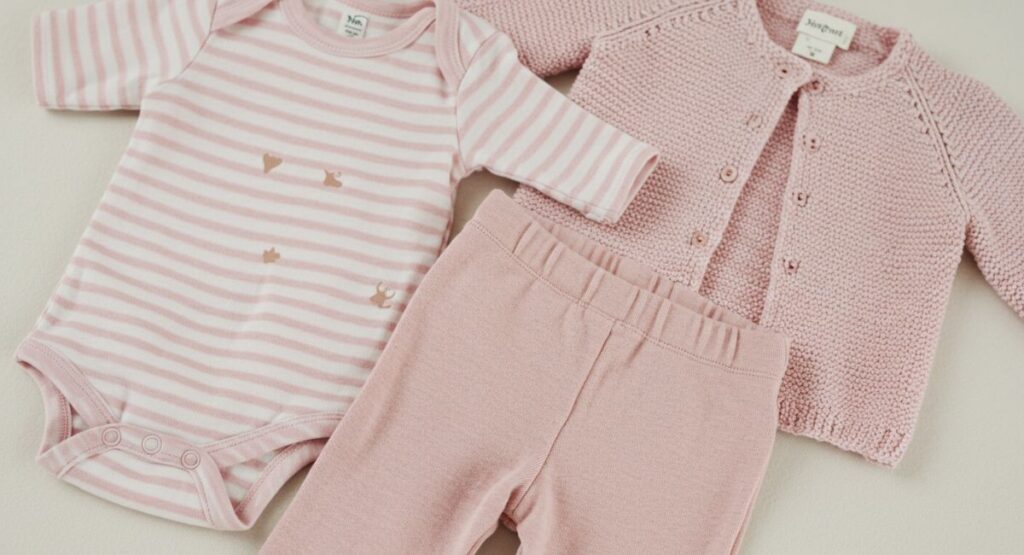
Maintenance and Longevity of Sun Protection Clothing
Preserving the protective qualities of your newborn sun protection clothing requires proper care:
Washing Recommendations
- Follow manufacturer instructions precisely
- Use mild, fragrance-free detergents designed for sensitive skin
- Avoid bleach and fabric softeners that can degrade UV protection
- Consider specialized detergents formulated for technical fabrics
Signs of Wear That Affect Protection
Be vigilant about replacing items when they show:
- Visible stretching in fabric
- Thinning areas
- Fading color (often indicates degrading UV protection)
- Loose seams or threads
Extending Garment Life
- Rotate multiple protective outfits to reduce wear on individual items
- Rinse chlorine and salt water promptly after use
- Air dry when possible, or use low heat settings
- Store out of direct sunlight when not in use
Most quality sun protective clothing maintains its UPF rating for approximately 40-50 washes when properly cared for.
Conclusion: Investing in Your Baby’s Skin Health
When it comes to newborn sun protection clothing, the choices you make now have lasting implications for your little one’s skin health. Investing in quality UPF 50+ garments, understanding proper use across different environments, and maintaining these specialized clothes appropriately creates a comprehensive shield against harmful UV exposure.
The most effective approach combines properly rated sun protective clothing with thoughtful sun exposure habits and environment modifications. By prioritizing these protective measures from the earliest days, you’re setting the foundation for a lifetime of healthy sun habits for your child.
Whether you choose premium brands with advanced fabric technologies or budget-friendly options with solid protection ratings, the key is consistency and complete coverage. Your baby’s delicate skin deserves the best protection available—and today’s innovative newborn sun protection clothing options make that easier and more effective than ever before.
What sun protection strategies have worked best for your little one? Share your experiences in the comments below, or sign up for our newsletter for more expert advice on keeping your baby safe and comfortable in all seasons.
Frequently Asked Questions
Do babies need sunscreen under sun protective clothing?
For newborns under six months, the American Academy of Pediatrics recommends avoiding sunscreen application when possible. Quality UPF 50+ clothing provides excellent protection without putting chemicals on sensitive skin. For exposed areas like hands and face, seek shade and use physical barriers. After six months, apply baby-safe mineral sunscreen to exposed areas not covered by protective clothing.
What UPF rating is necessary for newborn sun protection clothing?
Experts universally recommend UPF 50+ for newborns, which blocks 98% or more of harmful UV radiation. Lower ratings may be acceptable for older children in less intense sun conditions, but for newborns, maximum protection is always preferred given their exceptionally vulnerable skin.
How do I know if my baby is getting too hot in sun protective clothing?
Monitor your baby for signs of overheating: flushed skin, dampness around the hairline or neck, irritability, lethargy, or rapid breathing. Choose lightweight, breathable UPF fabrics designed specifically for hot weather. Many advanced sun protective fabrics now incorporate cooling technologies that wick moisture while maintaining protection.
Can regular white cotton clothing protect my newborn from the sun?
No, standard white cotton typically offers minimal protection (approximately UPF 5-7), blocking only about 85% of UV rays. This is significantly less than the 98%+ protection provided by UPF 50+ clothing. White cotton becomes even less protective when wet, potentially dropping to UPF 3, allowing about 33% of UV radiation to reach the skin.
How long does the UV protection last in baby sun clothing?
The UPF protection in quality sun clothing typically maintains effectiveness for approximately 40-50 washes when properly cared for according to manufacturer instructions. Premium brands often have treatments that last the lifetime of the garment. Watch for signs of deterioration like fabric thinning, significant stretching, or color fading, which may indicate diminished protection.
Author’s Top Picks
- Best Dog Sun Protection Clothing to Keep Your Pup Cool & Safe
- Is SPF 15 Enough for sun protection? What the Best Dermatologists Say
- Bandaids & Sun Protection: Do Bandaids Protect Scars from the Sun?
- Top Picks for the Best Sun Protection Clothing Women’s This Season
- Best Sun Protective Clothing for Beach Days, Hikes & Everything In Between

